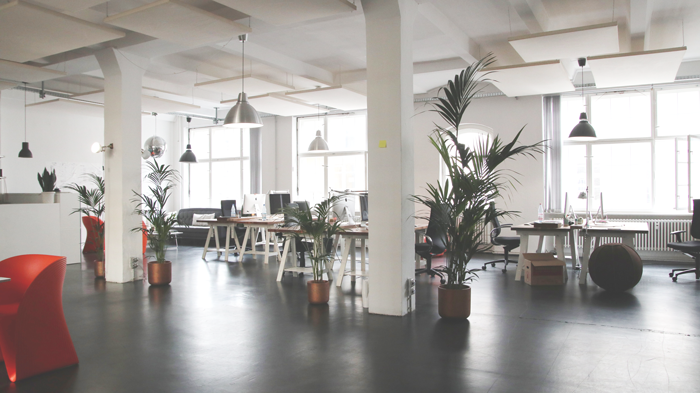
Why are Standing Desks Replacing Cubicles?
Ask any office worker, and they will certainly have a tale or two about life in a cubicle. The cubicle has been a workplace fixture for more than fifty years, but are they on their way out?
The evolution of office design in the last 15 years has shifted from cubicle dominated office spaces to open concept layouts with sit-to-stand desks.Whether this is a popular move or not depends on who you talk to. But one thing is for certain; the cubicle was certainly not conducive to a healthy and active work environment.
Let’s begin with a testimony from a company who, having taken a proactive approach to their employees’ well-being, took positive steps that are becoming more indicative of a new emphasis on employee health.
Mark from Globus, a vacation tour agency, needed to accommodate a large number of additional employees in their call center as well as an ergonomic solution that fit into their wellness program. They had to either move to a new building or decide to remove their existing cubicle setup. Globus opted for an open concept and went with 126 sit-stand desks from MojoDesk, adding room for 35% more employees in the same space.
“We found (them) online, and coincidentally, we actually had a Xybix sit-stand desk from the late 1990s that is still functioning in our training department.” After taking a look at the facilities and what they had to offer, Mark’s company went with MojoDesk…the long-lasting quality of their training department desk having a big influence in their decision.
“We ended up purchasing 126 fully-equipped adjustable standup desks at a bulk discount from MojoDesk.” But the bottom line is the company was, “excited to be able to offer our employees the option of sitting or standing throughout the day.”
This testimony reflects a shifting attitude toward employee well-being that is quickly catching on around the world.
So, what’s wrong with the cubicle?
93% of Americans who work in a cubicle will tell you that it is the worst of all the facets of office life. They would prefer any other work arrangement over the cubicle.
The number one complaint is noise. Though this may be common with other workplace setups, it’s more of an issue when the source of the noise is unknown. While sitting and working at your desk in the cubicle, you may hear the noise but not knowing the source limits your ability to do something about it.
And in a University of Sydney study, it was shown that cubicle workers expressed a very high degree of dissatisfaction in thirteen of fifteen categories studied, including noise, lighting, and air quality.
To top it off, they are not visually appealing. No one likes looking at a sea of communal looking cubicles.
They are confining.
The cubicle is associated with a working space that feels cramped---there is not a lot of room to move around. If one adds a file cabinet and a bookshelf to the confines of the cubicle, there is even less space.
They are unhealthy.
Your environmental comfort plays largely into your health. Does your immediate workspace meet your basic physical, functional, and psychological needs? The cubicle generally fails in all three areas.
If the workspace doesn’t fit your physical needs, the ability to move around and have plenty of space to perform all of your duties, then your stress levels rise. When that happens, tensions rise, illnesses can appear, and…there are dozens of stress-related health problems that can affect the cubicle worker.
Functional comfort is a measurement of the ergonomics of your work environment. This includes everything from the lighting overhead to the chair you sit in.
The very nature of the cubicle is one-size-fits-all. The furnishings are purchased in bulk, and all the cubicles are set up alike rather than customized for the individual worker’s size and shape. The one-size-fits-all forces one to adapt to what’s available and, among other things, this can lead to improper posture which, in turn, creates uncomfortable musculoskeletal conditions that lead to problems with the back, neck, and shoulders.
Even practicing perfect posture still doesn’t solve the issue of prolonged sitting. In fact, sitting too long leads to fatigue, which then affects your posture as you tire. One should try to stand and move around every so often…but then, you don’t have much room to do that. Are you starting to get the picture?
Finally, there is the feature of psychological comfort. This results when the worker feels they have ownership of their situation and are in control---they feel like they belong there. This is certainly not the way it is in a cookie-cutter workplace created by someone else.
The psychological aspect of being in an environment that is not comfortable and to your liking affects your concentration. Not being able to concentrate on the work at hand, again, causes stress. Repeated exposure to stress creates a condition called the allostatic load.
According to Wikipedia, “allostatic load is ‘the wear and tear on the body’ which grows over time when the individual is exposed to repeated or chronic stress. It represents the physiological consequences of chronic exposure to fluctuating or heightened neural or neuroendocrine response that results from repeated or chronic stress.”
The allostatic load has been linked to disorders such as chronic fatigue, musculoskeletal problems, depression, and conditions such as high blood pressure and heart attack.
When considering the evidence presented above, it’s not surprising at all that companies are beginning to tear down those cubicle workplaces and are progressing toward a healthier work environment.
A quote from How Stuff Works in their Death by Cubiclearticle sums it all up; “At work, where we're so often encouraged to think outside the box, we're trapped in one.”
The open office concept.
Certainly, the paradigm of the cubicle workplace must die…before all the workers do!
Seriously, the failure of the cubicle to satisfy even one of the conditions above should be reason enough to consider eliminating the cubicle workspace. But it goes beyond just the environmental aspects.
New workplace design is centered around the concept of facilitating creativity, involvement, and innovation. The ability to work, and to network, at the same time is a prevailing thought in new design.
The primary goal of the open-plan concept is to encourage communications and collaboration. Even in an organization with a rather strict hierarchy, the open concept gives the employee a sense of ease and a feeling that they are connected with the others in their group. They are working side-by-side with their superiors, and their peers and everyone is headed in the same direction.
This is significantly important for new employees. It has been shown that they are quicker to learn and join in more readily with group projects. This creates confidence in the new employee, and they are quickly welcomed into the fold.
Include the sit-stand desk in the plan…from MojoDesk, of course!
Provide the workers with a sit-to-stand desk, and the wellness factor is nearly complete.
In a recent study by the Icahn School of Medicine at Mount Sinai, in collaboration with researchers from the Center for Active Design, it was shown that office workers claim that they feel better physically, they are more active, on and off the job, and are considerably more productive if given the opportunity to both sit and stand while working.
Sixty-one percent of the workers in the study group who utilized a sit-to-stand desk stated that they felt the desk “positively improved their health…outside the workplace as well.” They went on to report that they were, “moving more, feeling stronger, more limber, and having less pain in muscles, joints, and back.” The study goes on to show that the participants became more aware of their posture as they stood at their desk…and many were motivated to try the concept at home.
The report describes how each worker felt that their productivity greatly increased when utilizing a sit-to-standing work desk. From the employer’s standpoint, this can, and will, provide a huge return on their investment.
It’s a win-win situation that starts with the idea of employee wellness in the work environment and culminates in an excellent ROI for the company.



